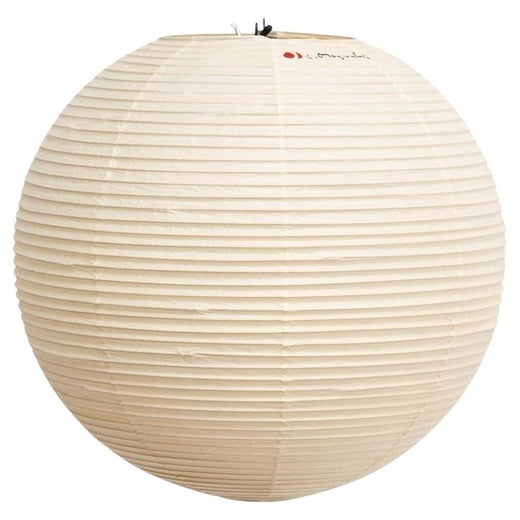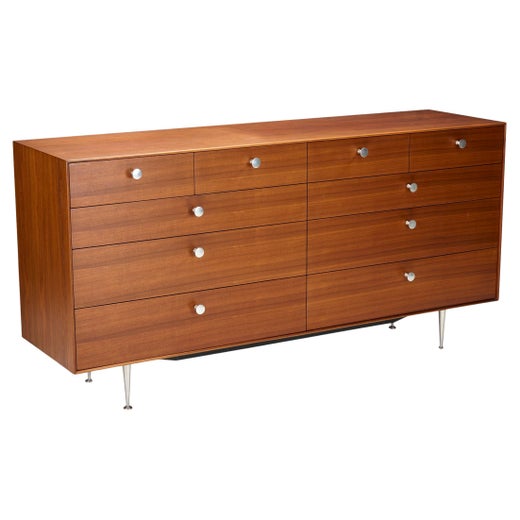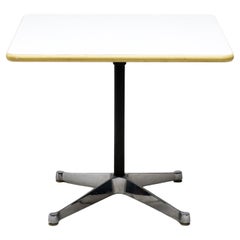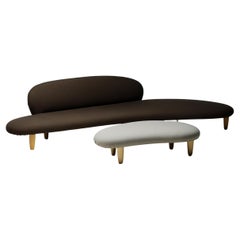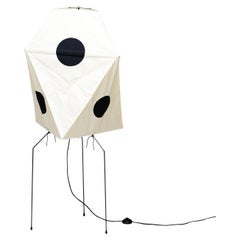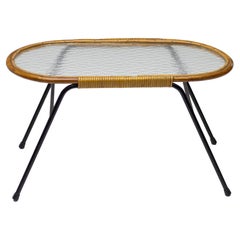IN-50 coffee table designed by Isamu Noguchi for Herman Miller
About the Item
- Creator:Isamu Noguchi (Designer),Herman Miller (Manufacturer)
- Dimensions:Height: 15.75 in (40 cm)Width: 50.01 in (127 cm)Depth: 35.44 in (90 cm)
- Style:Mid-Century Modern (Of the Period)
- Materials and Techniques:
- Place of Origin:
- Period:
- Date of Manufacture:circa 1950
- Condition:Wear consistent with age and use. Minor losses. Original glass top shows heavy wear from age and consistent use, one minor chip at the edge. Base shows signs of lacquer retouches in a few areas upon close inspection. Overall great vintage condition.
- Seller Location:Dronten, NL
- Reference Number:1stDibs: LU9314928282
Isamu Noguchi
A sculptor, painter, ceramicist and furniture and lighting designer, Isamu Noguchi was one of the most prolific and protean creative forces of the 20th century and a key figure in the development of organic modernism. Noguchi’s sculptures and designs — his chairs and tables as well as his timeless Akari lamp and other lighting fixtures — share a common spirit: one of lyrical abstraction, tempo and flow and harmonious balance.
Noguchi was born in Los Angeles to an American mother and Japanese father, and spent most of his childhood in Japan. He returned to the United States at age 13, went to high school in Indiana and enrolled at Columbia University to study medicine. At the same time, he took night courses in sculpture.
Within three months, Noguchi left college to pursue art full time. Noguchi was awarded a Guggenheim Fellowship in 1927 and traveled to Paris to work under Constantin Brancusi. It marked a turning point. Inspired by Brancusi, Noguchi embraced abstraction and began to sculpt in the expressive, rhythmic style that would be the hallmark of his work.
Once back in New York, Noguchi was introduced to design by what would become a lifelong collaboration creating sets for choreographer Martha Graham. His first industrial designs were in Bakelite: the sleek Measured Time kitchen timer created circa 1932, and his famed Zenith Radio Nurse intercom, from 1937.
Ten years later, Herman Miller introduced Noguchi’s now-iconic glass-topped coffee table with an articulated wooden base. His washi paper and bamboo Akari light sculptures, handmade in Japan, debuted in 1951. In the late 1950s, Noguchi designed for Knoll, creating such pieces as his dynamic Cyclone table and rocking stool.
For collectors, Noguchi’s furniture and lighting designs remain his most accessible work — they have the same power and presence that Noguchi brought to his art.
Find vintage Isamu Noguchi floor lamps, table lamps, coffee tables and other furniture on 1stDibs.
Herman Miller
No other business of its kind did more than the Herman Miller Furniture Company to introduce modern design into American homes. Working with legendary designers such as Charles and Ray Eames, George Nelson and Alexander Girard, the Zeeland, Michigan-based firm fostered some of the boldest expressions of what we now call mid-century modern style. In doing so, Herman Miller produced some of the most beautiful, iconic and, one can even say, noblest chairs, sofas, tables and other furniture ever.
Founded in 1923, Herman Miller was originally known for grand historicist bedroom suites: heavily ornamented wood furniture that appealed to a high-minded, wealthier clientele. The company — named for its chief financial backer — began to suffer in the early 1930s as the Great Depression hit, and D.J. De Pree, the company’s CEO, feared bankruptcy. In 1932, aid came in the form of Gilbert Rohde, a self-taught furniture designer who had traveled widely in Europe, absorbing details of the Art Deco movement and other modernist influences. After persuading De Pree that the growing middle class required smaller, lighter household furnishings, Rohde set a new course for Herman Miller, creating sleek chairs, tables and cabinetry that were the essence of the Streamline Moderne style.
Rohde died suddenly in 1944. The following year, De Pree turned to George Nelson, an architect who had written widely about modern furniture design. Under Nelson’s leadership, Herman Miller would embrace new technologies and materials and audacious biomorphic forms.
Some of the pieces the company produced are now emblems of 20th century American design, including the Eames lounge chair and ottoman and Nelson’s Marshmallow sofa and Coconut chair. Such instantly recognizable furnishings have become timeless — staples of a modernist décor; striking, offbeat notes in traditional environments.
Find a range of vintage Herman Miller office chairs, desks, coffee tables and other furniture on 1stDibs.
You May Also Like
Vintage 1950s American Modern Coffee and Cocktail Tables
Glass, Birch, Paint
Late 20th Century American Mid-Century Modern Coffee and Cocktail Tables
Glass, Cherry
Vintage 1940s American Mid-Century Modern Coffee and Cocktail Tables
Uranium Glass, Ash
Mid-20th Century American Mid-Century Modern Coffee and Cocktail Tables
Aluminum
Late 20th Century Modern Coffee and Cocktail Tables
Glass, Wood
Vintage 1950s American Mid-Century Modern Dining Room Tables
Steel
20th Century American Coffee and Cocktail Tables
Travertine
Mid-20th Century American Mid-Century Modern Coffee and Cocktail Tables
Aluminum
Vintage 1950s American Mid-Century Modern Coffee and Cocktail Tables
Ash
Vintage 1960s American Mid-Century Modern Coffee and Cocktail Tables
Aluminum
More From This Seller
View AllVintage 1960s American Mid-Century Modern Coffee and Cocktail Tables
Aluminum, Chrome
21st Century and Contemporary Swiss Mid-Century Modern Sofas
Wool, Walnut
Mid-20th Century Japanese Mid-Century Modern Floor Lamps
Steel
Vintage 1950s Dutch Mid-Century Modern Coffee and Cocktail Tables
Steel
Mid-20th Century American Mid-Century Modern Stools
Walnut
Mid-20th Century American Mid-Century Modern Office Chairs and Desk Chairs
Aluminum
Still Thinking About These?
All Recently ViewedRead More
A New Exhibition Spotlights the Nuance of 1940s Art and Design
Works by a range of designers and artists prove that the constraints of the time didn't stifle creativity.
How Noguchi Elevated Ashtrays to Objets d’Art
Smoking might have fallen out of fashion, but these ashtrays have enduring design appeal.
